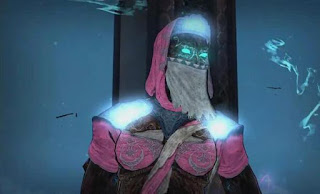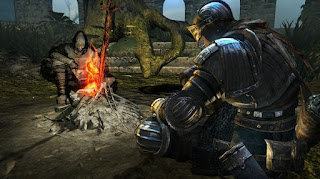Throughout the first week of this course, two names from our readings and class discussions kept buzzing around my mind looking for a place to connect: Ahriman and Ahura Mazda. I knew I had heard them before, and I had a vague idea, even without the readings and class discussions, what concepts they might represent, but where had I heard these names before kept bugging me. They sounded so familiar, but I had no idea where or when I had heard them.
Then, like a blast of recognition (possibly from Ohrmazd himself), I remembered: The Prince of Persia.
More specifically, this particular game from 2008:
 |
| From IGN.com |
Looking back, I should not have been so surprised that a few video game developers working on a title based in the time of the Persian Empire looked to the Persian religion of Zoroastrianism for its influences, but the depth and faithfulness to the religion's story was the most surprising to me. In addition to the general theme of the game (banishing a darkness that has infected the world), this video game acquaints you on familiar terms with the desires of Ahriman and Ohrmazd. Unfortunately, the game itself wasn’t the best, but the story was engaging and has now become even more interesting with this connection to Zoroastrianism.
Let’s take a look at the story.
You begin the game with the world looking like this:
 |
| From IGN.com |
Then Ahriman is released, and it turns into this:
 |
| From Hardcoregaming101.net |
Now, let’s see what the Greater Bundahishn has to say about Ahriman’s release into the world (From Tablet IV):
11. He made the world so much invisible, at noon, that [the Sky held the darkness, below and above the Earth,] just like a dark night....
15. He let loose noxious creatures over the Earth; biting and venomous [noxious creatures,] such as [the dragon,] serpent, scorpion, [venomous lizard, tortoise,] and frog, [so crawled and thereby polluted the Earth] that he did not leave [any part of the Earth] even as much as the point of a needle free from noxious creatures. [51] [16. Thereupon, the Earth spoke: " May revenge come to these revengers, in this dispensation in which they are produced."]
17. He [so] brought poison over the Tree that it withered immediately.
[18. Thereupon, the Spirit of the Tree spoke: "Owing to her devotion, Ohrmazd will cause the Tree to grow."]
19. He let loose Greed, Needfulness, [Pestilence,] Disease, Hunger, Illness, Vice and Lethargy on the body of , Gav' and Gayomard...
From Avesta.org
As you can see with the screenshot above, there is a tree that has been corrupted. There is also a man, the Prince, and a woman, a priestess named Elika. Although their names are not "Gav'" and "Gayomard," SPOILERS FOR THE GAME, just as Gav' dies in the story, so does Elika pass away in the game.
Although the game does take some interesting liberties with the story of Ahriman's release, there are still servants and creatures that he lets loose. One of the most interesting, with her connection to the religious story, is the character the game calls the Concubine:
 |
| From thegamecritique.com |
Perhaps the evil spirit-woman “Jahi” in the Greater Bundahishn who convinces Ahriman to arise from his stupor of 3000 years influenced the creation of this particular video game character and her motives?
Overall, the goal of the game is to “cure” these afflicted lands with Ohrmazd's/Ahura Mazda's power that flows through Elika, eventually returning the world from its corrupted state to its natural state and conquering the forces of darkness in the process.
At the end, you fight Ahriman, of course. It is an interesting fight, and one that is seen through the deity's point of view. (Unfortunately, I could only find the video of this fight in Italian on YouTube... Maybe you can pretend Ahriman is the devil in Dante's Divine Comedy while on vacation?)
The story of this game has always interested me and "stuck" with me, even though the last time I played this game was many years ago. It seems as if, like what was discussed in class, Zoroaster tapped into something primordial about the human condition and our innate fear of darkness. Could it be that human societies and their effects on religion (or vice versa) led to this trope being so common and so influential? Not only is the theme of darkness vs. light common in religion and religious symbology, but as we have just seen, that theme is continued in current video games like the Prince of Persia and in Dark Souls.
As a quick side note, Dark Souls is infamous for being an extraordinarily difficult game, and you are only safe at places called “bonfires.” These bonfires are sources of light and comfort in a dark and hostile world. These havens are where you level up, become stronger, and rest the character before going out to fight the creatures of the coming darkness.
 |
| A Bonfire.... From dark souls.wikia.com |
In addition to this, the game's predecessor, Demon's Souls, begins its story with a dark fog covering the world that you must fight against. (From Software, the developers, must have a "thing" for this darkness trope.)
 |
| Fog over the land in Demon's Souls... From demonssouls.wikidot.com |
Since darkness and the unknown are such common fears throughout human history, a creature that embodies the "evil" of those things is an attractive foe to rally against. Along with that enemy, it seems that a "champion” of the light who is meant to oppose and overcome them is an essential ingredient for this mythology “working”, and perhaps our hope for goodness ultimately prevailing is one of the reasons for this trope’s enduring legacy. From the Enuma Elish and Beowulf to the New Testament, The Neverending Story and to the latest video games, Zoroaster’s philosophy and his dark servants of Ahriman seemed to have influenced the past and will continue to shape our philosophies in unprecedented ways.
No comments:
Post a Comment